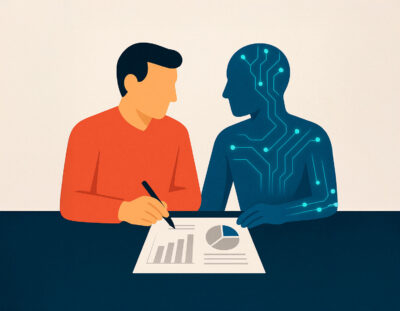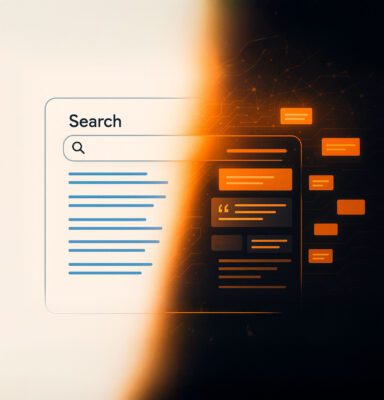Client conference room meetings look different these days. Alongside the usual suspects, the Director of Sales reviewing quarterly projections, the Marketing Manager discussing market trends, there’s often a new presence that isn’t quite human but isn’t quite software. It’s artificial intelligence, and in 2025, it has finally grown enough to earn a seat at the table.
But here’s what might surprise you: the most successful companies aren’t the ones that have replaced their employees with algorithms. They’re the ones that have figured out how to make AI and humans dance together in ways that amplify what each does best.
The Revolution That Actually Happened
Remember when (well, I guess even still today) everyone thought AI would either save the world or end it? The reality, as usual, has landed somewhere more interesting. Today’s artificial intelligence is simultaneously more powerful and yet somewhat more mundane than the prophets predicted. It’s not the omniscient Terminator-type overlord of science fiction, but neither is it the overhyped technology that some dismissed.
What we have in 2025 is something more nuanced: AI that can outperform humans at specific tasks while still needing human wisdom (and experience) to make sense of the world. Think of it as hiring a savant – brilliant within their domain, surprisingly limited outside of it,tely dependent on good management to deliver value. I often draw a parallel to it (currently) being the best paralegal ever, but remind the user that as the licensed attorney, you must make sure that what is presented is correct, as you are essentially underwriting it.
The numbers tell the story. It’s estimated that more than eight out of ten major companies now consider AI a priority, and nearly three-quarters are using it in some way. But here’s the catch: while some leaders are seeing returns of 20 to 30% on their AI investments, the average is 10 to 15%. The difference? It’s not about who has the best tech. It’s about who best understands how to blend artificial and human intelligence.
The AI Ecosystem: It's More Than Just ChatGPT
When most people think of AI today, they picture chatbots that can write poetry or generate images of cats in spacesuits. But in the business world, AI has evolved into a complex ecosystem of specialized tools, each for different challenges. Predictive AI, the “old guard” that has been around quite a while, though not as well-known as today’s utilizations, has been quietly transforming operations for years. These systems are great at pattern recognition – spotting the subtle signals that indicate a machine is about to fail, a customer is about to leave, or demand is about to spike. A manufacturing plant using predictive maintenance can cut downtime by 30 to 50%, not through magic but through the patient analysis of vibration patterns, temperature fluctuations, and historical failure data.
Then there’s generative AI, the creative whiz kid that captured the world’s imagination. I may be aging myself, but it’s kind of like when the World Wide Web became available to surf via Browsers while many never realized there was an Internet well before that occurred.
These systems don’t just analyze; they create (hence generative).
Marketing teams use them to generate campaign ideas, engineers use them to explore design alternatives, and writers use them to overcome “blank page” syndrome. But here’s what the hype often misses: the best outputs still require human curation. AI may be able to generate a thousand ideas in the time it takes a human to think of one, but knowing which idea will resonate with your market? That’s still uniquely human territory.
Computer vision systems have moved from interesting experiments to industrial workhorses. On factory floors they spot defects that human eyes might miss after hours of repetitive inspection. In warehouses they track inventory with superhuman accuracy. In retail stores they analyze customer behavior patterns to optimize layouts and reduce theft. The technology has become so reliable that many quality control processes now achieve accuracy rates above 95%.
Natural language processing (NLP) – the technology that lets machines understand and generate human language- has perhaps developed the most from its origins. Today’s systems don’t just transcribe speech or translate languages; they understand context, detect sentiment, and can maintain coherent conversations across complex topics. Customer service departments that once needed armies of reps to handle routine queries now use NLP-powered systems to resolve 60 to 80% of issues without human intervention.
But perhaps the most interesting development is the emergence of agentic AI – systems that don’t just respond to commands but work towards goals. Unlike traditional AI that waits for prompts, agentic AI systems can plan, execute, and adapt. Imagine delegating a research project to an AI that then identifies what information it needs, searches multiple sources, synthesizes findings, and presents recommendations – all while checking in for guidance on critical decisions.
“This isn’t science fiction; it’s happening in forward-thinking companies today.
The Learning Curve and How AI Gets Smart
Understanding how AI learns isn’t just a technical curiosity – it directly impacts what you can expect from these systems and where they might fail. The methods used matter because they determine everything from cost and reliability to the types of problems AI can solve.
Most business AI today relies on supervised learning, which works much like training a new employee. You show the system examples of what you want – this is a defective product, this is a satisfied customer, this is a fraudulent transaction – and it learns to recognize similar patterns. It’s powerful but labor-intensive, requiring humans to label thousands or millions of examples. The payoff comes in consistency. Once trained, these systems apply the same standards tirelessly, without the variations that come from human fatigue or subjective judgment.
Unsupervised learning takes a different approach, finding patterns in data without being told what to look for. It’s like hiring a brilliant analyst and saying, “Tell me something interesting about our customers.” The system might discover customer segments you never knew existed or identify anomalies that conventional analysis would miss. The challenge is that you can’t always predict or control what it will find, which poses many many today.
The newest approaches blend human knowledge with machine learning in clever ways. Retrieval-Augmented Generation, or RAG, has become the go-to method for creating AI systems that can work with proprietary company information. Instead of trying to train an AI on all your company’s documentation (expensive and risky), RAG systems retrieve relevant documents on demand and use them to generate accurate, contextual responses. It’s like giving an intelligent assistant access to your company’s entire knowledge base, with the ability to instantly find and synthesize the most relevant information. Chunking your data into digestible sets of data also help keep the AI on point as it focuses on developing responses to your queries.
A company wanting to analyze customer feedback doesn’t need to train a language model from zero; they can take a pre-trained model that already understands language and adapt it to their specific needs. It’s the difference between teaching someone to read versus teaching them to understand your industry’s jargon.
The Human Element and Why Success Still Depends on People
Here’s what the AI revolution has taught us: the technology is only as good as the humans who deploy it. The companies seeing the best returns aren’t necessarily the ones with the most advanced AI. They’re the ones that have figured out how to create productive partnerships between human expertise and artificial intelligence. Consider a global logistics company that recently deployed AI for route optimization. The system could process thousands of variables – traffic patterns, weather forecasts, delivery priorities, vehicle capacities – and suggest optimal routes in seconds. That said, it is the veteran dispatchers who knows that certain customers always needed deliveries before 10 AM for their production schedules, that specific drivers were experts at navigating particular neighborhoods, and that some routes looked good on paper but were nightmares in reality – and in todays world that level of detail may not be in systems to be lcontemplated by the AI.
By combining the AI’s computational power with human insights, the company achieves something neither could accomplish alone: a 25% improvement in delivery efficiency while actually increasing customer satisfaction. The AI handled the number-crunching; the humans provided the context and caught the edge cases.
This pattern repeats across industries. In healthcare, AI can analyze medical images with remarkable accuracy but it’s the radiologist who understands the patient’s history and can spot when something doesn’t quite fit the pattern. In finance, AI can flag potentially fraudulent transactions but it’s the analyst who can distinguish between genuine fraud and a customer’s unusual but legitimate behavior. Granted, things are progressing quickly and the gap may close more shortly, but for now the collaborative opportunity is clear.
With Great Power Comes Great Responsibility… and Complexity
AI introduces risks that traditional business frameworks weren’t designed to handle. Understanding these challenges isn’t about fear-mongering; it’s about being prepared.
Hallucination – AI’s tendency to confidently provide incorrect information – remains one of the most perplexing challenges we must be cognizant of. Unlike human errors, which often come with uncertainty or hedging, AI can be wrong with complete confidence (and you will easily believe it). This makes human oversight absolutely essential, especially for high-stakes decisions.
Bias in AI systems reflects – and can amplify – human prejudices present in training data. A hiring system trained on historical data might perpetuate past discrimination. A lending algorithm might unfairly disadvantage specific neighborhoods. The solution isn’t to avoid AI but to actively monitor and correct for these biases, treating fairness as an ongoing process rather than a one-time fix.
Privacy and security also take on new dimensions when AI systems can infer sensitive information from seemingly innocent data. Companies must think very carefully about what data they feed into AI systems and how they protect both the data and the models themselves.
The Economics of Intelligence
The business case for AI has evolved from speculative to specific. Early adopters chased the technology for its own sake; today’s implementations focus on measurable returns. The math has become clearer and will continue to do so: successful AI deployments typically pay for themselves within 12-18 months through a combination of efficiency gains, revenue enhancement, and strategic advantages. Efficiency gains are the most tangible. When AI takes over routine tasks – document processing, basic customer queries, standard analysis – human workers can focus on higher-value work. But the real magic happens when AI doesn’t just speed up existing processes but enables entirely new approaches.
A pharma company using AI for drug discovery isn’t just finding molecules faster; it’s exploring chemical spaces that human researchers might never have considered. A retailer using AI for personalization isn’t just improving recommendations; it’s creating individual experiences for millions of customers at once.
The strategic advantages are harder to measure but often most valuable. Companies using AI for market intelligence can see trends before competitors. Those using it for innovation can explore more ideas faster. The cumulative effect is a kind of compound advantage that grows over time.
2025 and Beyond
As we move through 2025 and beyond several trends are shaping the AI landscape. Multimodal AI – systems that work with text, images, audio, and video – is becoming the norm rather than the exception. Agentic AI is moving from experimental to practical / day-to-day, and will change how we think about delegation and automation.
Edge AI is bringing intelligence to where it’s needed, enabling real-time decisions without cloud connectivity. This opens up new possibilities in manufacturing, autonomous vehicles, and remote operations. Meanwhile, regulatory frameworks are finally catching up, providing clearer guidelines for responsible AI use.
But perhaps the most important trend is the growing recognition that AI success isn’t about the tech alone. It’s about creating organizations that can effectively combine human and artificial intelligence. This means new skills, new processes and often new ways of thinking about work itself.
So when you’re at that dinner party talking to colleagues and friends about AI remember this: we’re in the middle of a big transformation, but it’s not the one we expected.
Instead of AI replacing humans, we’re seeing the emergence of human-AI teams that outperform either working alone.
The winners in this new world won’t necessarily be the companies with the most advanced AI or the most aggressive automation. They’ll be the ones that best understand how to combine artificial intelligence with human wisdom and create something greater than the sum of its parts.
The revolution is real, but it’s a revolution of augmentation – not replacement. And that’s a conversation worth having – whether in the boardroom or over dinner.
Joseph DeMicco brings over 30 years of experience to his roles as founder and CEO of Amplify Industrial Marketing + Guidance, founder of Industrial Web Search, and instructor for the Goldman Sachs 10,000 Small Businesses program, specializing in data-driven marketing strategies.



